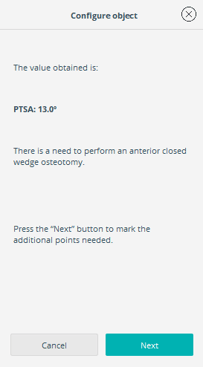Last updated on July 6 2022
Description
Posterior tibial slope (PTS) is an important factor in the knee joint biomechanics and one of the bone features, which affects knee joint stability. The tibial slope is defined as the angle between the line perpendicular to the longitudinal axis of the tibia (LAT) and the posterior inclination of the tibial plateau.
An increased tibial slope is claimed to be one of the ACL injury risk factors. It is believed that the increase in the angulation of the tibial slope generates an increased force on the ACL, which may cause it to rupture or, in the case of post-reconstruction, insufficiency or weakening of the graft.
Measurements
The measurements made by the procedure are displayed in the image:
- Posterior tibial slope angle (PTSA): the angle between the line drawn tangent to the surface of the tibial plateau and the line perpendicular to the longitudinal axis of the tibia (LAT).

Auxiliary references
To show this procedure, PeekMed® needs additional references:
- Longitudinal axis of the tibia (LAT): a line passing through two points located in the center of the anterior-posterior width of the tibia on the proximal diaphysis;
- Tibial plateau tangent line (TPTL): a tangent line to the proximal tibial articular surface;
- Auxiliary PTSA line: a line always perpendicular to LAT.
How to perform
After selecting this procedure in the sidebar, as well as, the side where you will perform the procedure, you must mark the points to conclude it. To see the caption of each point you need to click on this button .
Beware: you can change the position of the points at this stage or later. To do this, simply click on each handle with the left mouse button and move them to the most suitable position.
For advanced configuration, please follow the instructions below.
Advanced Configuration
After the correct positioning of the PTSC points, it is possible to evaluate if the patient needs a correctional procedure. If so, an Anterior Open Wedge Osteotomy or an Anterior Closed Wedge Osteotomy can be suggested, depending on the patient's measurements, using its corresponding option in the Object edition.

Based on the value obtained (PTSA), the procedure configuration will suggest a type of osteotomy. After determining the deformity, a second set of points should be marked.
Point 7 - Mark a point at the superior edge of the $si
de tibial tuberosity.
Point 8 - Mark a point at the $side tibial insertion of the posterior cruciate ligament.
After marking the points, it is possible to perform the Osteotomy by clicking Finish.
 |
 |
